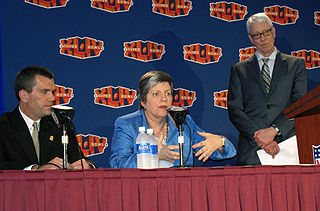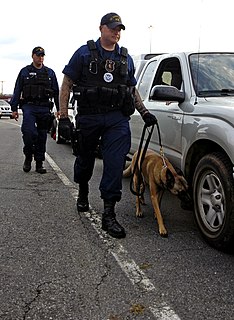Related Research Articles

The Federal Emergency Management Agency (FEMA) is an agency of the United States Department of Homeland Security, initially created by Presidential Reorganization Plan No. 3 of 1978 and implemented by two Executive Orders on April 1, 1979. The agency's primary purpose is to coordinate the response to a disaster that has occurred in the United States and that overwhelms the resources of local and state authorities. The governor of the state in which the disaster occurs must declare a state of emergency and formally request from the president that FEMA and the federal government respond to the disaster. The only exception to the state's gubernatorial declaration requirement occurs when an emergency or disaster takes place on federal property or to a federal asset—for example, the 1995 bombing of the Alfred P. Murrah Federal Building in Oklahoma City, Oklahoma, or the Space Shuttle Columbia in the 2003 return-flight disaster.

A National Special Security Event (NSSE) is an event of national or international significance deemed by the United States Department of Homeland Security (DHS) to be a potential target for terrorism or other criminal activity. These events have included summits of world leaders, meetings of international organizations, presidential nominating conventions and presidential inaugurations. NSSE designation requires federal agencies to provide full cooperation and support to ensure the safety and security of those participating in or otherwise attending the event, and the community within which the event takes place, and is typically limited to specific event sites for a specified time frame.

The Critical Incident Response Group (CIRG) is a division of the Criminal, Cyber, Response, and Services Branch of the United States Federal Bureau of Investigation. CIRG enables the FBI to rapidly respond to, and effectively manage, special crisis incidents in the United States.

The Special Operations Engineer Regiment (SOER) is a specialised unit of the Australian Army. The Regiment forms part of the Special Operations Command. The unit was formed in 2002 as the Incident Response Regiment (IRR), they are deployed to respond to chemical, biological, radiological, nuclear or explosive incidents. The Regiment was transferred into the newly raised Special Operations Command in 2003. In 2010 and 2011 its role changed to supporting the army's special forces units, and it was renamed accordingly.

The National Disaster Medical System (NDMS) is a federally coordinated healthcare system and partnership of the United States Departments of Health and Human Services (HHS), Homeland Security (DHS), Defense (DOD), and Veterans Affairs (VA). The purpose of the NDMS is to support State, local, Tribal and Territorial authorities following disasters and emergencies by supplementing health and medical systems and response capabilities. NDMS would also support the military and the Department of Veterans Affairs health care systems in caring for combat casualties, should requirements exceed their capacity.

Canadian Special Operations Forces Command is a command of the Canadian Armed Forces. It is responsible for all special forces operations that are capable of responding to terrorism and threats to Canadians and Canadian interests around the world.
The National Warning System (NAWAS) is an automated telephone system used to convey warnings to United States-based federal, state and local governments, as well as the military and civilian population. The original mission of NAWAS was to warn of an imminent enemy attack or an actual accidental missile launch upon the United States. NAWAS still supports this mission but the emphasis is on natural and technological disasters. Organizations are able to disseminate and coordinate emergency alerts and warning messages through NAWAS and other public systems by means of the Integrated Public Alert and Warning System.
The counter-terrorism page primarily deals with special police or military organizations that carry out arrest or direct combat with terrorists. This page deals with the other aspects of counter-terrorism:
The United States National Response Framework (NRF) is part of the National Strategy for Homeland Security that presents the guiding principles enabling all levels of domestic response partners to prepare for and provide a unified national response to disasters and emergencies. Building on the existing National Incident Management System (NIMS) as well as Incident Command System (ICS) standardization, the NRF's coordinating structures are always in effect for implementation at any level and at any time for local, state, and national emergency or disaster response.

The Center for Domestic Preparedness is the only U.S. federal facility chartered to provide comprehensive preparedness training programs to the nation’s emergency response providers. In 2007, the CDP became part of the Federal Emergency Management Agency (FEMA).
Presidential Decision Directive 62 (PDD-62), titled Combating Terrorism, was a Presidential Decision Directive (PDD), signed on May 22, 1998 by President Bill Clinton. It identified the fight against terrorism a top national security priority.

The National Nuclear Security Administration (NNSA) is a United States federal agency responsible for safeguarding national security through the military application of nuclear science. NNSA maintains and enhances the safety, security, and effectiveness of the U.S. nuclear weapons stockpile without nuclear explosive testing; works to reduce the global danger from weapons of mass destruction; provides the United States Navy with safe and effective nuclear propulsion; and responds to nuclear and radiological emergencies in the United States and abroad.
Defense Support of Civil Authorities (DSCA) is the process by which United States military assets and personnel can be used to assist in missions normally carried out by civil authorities. These missions have included: responses to natural and man-made disasters, law enforcement support, special events, and other domestic activities. A recent example of the use of DSCA is the military response to Hurricane Katrina. DSCA is the overarching guidance of how the United States military can be requested by a federal agency and the procedures that govern the actions of the military during employment.
A Weapons of Mass Destruction Civil Support Team supports civil authorities in the event of the use, or threatened use, of a weapon of mass destruction. CSTs are federally funded units established under Presidential Decision Directive 39. There are 57 National Guard and one Army Reserve full-time teams: one in every U.S. state, Washington, D.C., Puerto Rico, Germany, Guam, and the US Virgin Islands with an additional team each in California, Florida, and New York.

The Deployable Operations Group (DOG) was a United States Coast Guard command that provided properly equipped, trained and organized Deployable Specialized Forces (DSF), which still exist today, to the Coast Guard, DHS, DoD and inter-agency operational and tactical commanders. Formerly headquartered in Arlington, Virginia, it was established on 20 July 2007, and was commanded by a captain and was decommissioned by the Commandant of the Coast Guard, Admiral Robert Papp on 1 October 2013, although many of the units existed long before the 2007 commissioning. Upon decommissioning, the units previously assigned to the DOG were split between Coast Guard Pacific and Atlantic Area commands.
A nuclear power plant emergency response team (ERT) is an incident response team composed of plant personnel and civil authority personnel specifically trained to respond to the occurrence of an accident at a nuclear power plant.

A Visible Intermodal Prevention and Response team, sometimes Visible Intermodal Protection and Response (VIPR) is a Transportation Security Administration program. Various government sources have differing descriptions of VIPR's exact mission. It is specifically authorized by which says that the program is to "augment the security of any mode of transportation at any location within the United States". Authority for the program is under the Secretary of Homeland Security. The program falls under TSA's Office of Law Enforcement/Federal Air Marshal Service. TSA OLE/FAMS shares responsibility for the program with the Office of Security Operations and Transportation Sector Network Management.
Operations Plus WMD is a training level in dealing with hazardous materials.
The National Domestic Preparedness Consortium (NDPC) is a training partner and established training arm of the U.S. Department of Homeland Security DHS/ FEMA. It is a professional alliance of seven national institutions and organizations that work to develop and deliver training, technical assistance, plan assessments, and exercises to emergency responders and first receivers at the territories, state, local and tribal levels. The members were chosen for their unique knowledge bases in the areas of chemical, biological, radiological, nuclear, explosive, medical, critical infrastructure, and incident management, and have enhanced their core competencies at the request of DHS and FEMA to include other areas as well. The following is a list of the NDPC members and their core competencies:

Robert J. Fenton Jr is an American governmental official who worked for the Federal Emergency Management Agency (FEMA) in 1996 and was appointed Regional Administrator for FEMA Region IX: Arizona, California, Hawaii, Nevada, and the Pacific Islands in July 2015. He had a leadership role in the development of the National Incident Management System and the National Response Framework.
References
- ↑ "Terrorism Incident Law Enforcement and Investigation Annex"", December 2004, accessed October 17, 2009
- 1 2 Jeffrey D. Brake, "Terrorism and the Military’s Role in Domestic Crisis Management: Background and Issues for Congress", April 19, 2001, accessed October 17, 2009
- ↑ "John A. Gordon Before the Subcommittee on Oversight and Investigations Archived 2009-06-18 at the Wayback Machine ", June 25, 2002, accessed October 17, 2009
- ↑ Reiss, Tom, "Now Will We Heed the Biological Threat?", The New York Times , February 21, 1998: 11